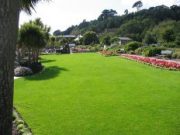
Here’s What Your Weekday Lawn Maintenance Checklist Should Look Like
A green yard is the landscapers’ dream and is almost as welcoming as a friendly dog. Besides boosting your landscape visual appearance, lawn that is green in color means it is healthy and strong enough to keep any weeds, pests and diseases at bay. Regardless of the season, your lawn requires your attention more than anything else in your yard, simply because it takes the largest part of it. Properly watering, regular fertilizing and weekly mowing are surely big musts, but they’re not enough.
Growing and maintaining a healthy and beautiful lawn does not require a lot of hours of landscaping work as much as it requires wise management. One great way to ensure your lawn is properly taken care of every week is to create a lawn maintenance checklist. The idea may sound a bit childish rather than efficient to you, but rest assured it will help you keep all things neat in your yard. Not only it is efficient and keeps you moving forward, but checking off the does you set for yourself can give you a sense of accomplishment too. If you decided to give it a try, here are 6 dos your weekly lawn maintenance must contain.
Watering: Watering is undoubtedly the most essential care tip for your lawn. Although it’s an obvious one, properly watering can be a bit tricky, as for how often and how much depends on multiple factors, such as your geographic location, your climate, type of grass and type of soil. If you live where the temperature goes beyond 100 Fahrenheit quite often, more frequent watering is of course required. The best time of the day to water an emerald-green lawn is early in the morning when the sun is still rising.
Mowing: Mowing is just as essential as watering and it is also known as a classical weekend activity. There are many different ways you can mow your grass, but usually it depends on the season. The ideal height also varies with each season. Over summer or during drought, you should allow any type of grass to grow taller, yet you should mow it once a week on a high setting. Over fall and spring, mowing once a week is also a must and over winter, weekly mowing is not necessary.
Eliminating weeds: Regardless of the type of grass, trees and shrubs you have in your yard, having a good control over weeds does a plenty of good for your lawn. A brief weekly walk around your landscape should be enough for you to identify any weeds that must go. Make sure to pull the weed off their root, because otherwise it will grow back. For the sneaky ones that hide among your lawn, you can apply a weed control product and wave them goodbye as well.
Edging Inspection: Any type of lawn starts showing some signs of wear when the summertime begins and that can certainly impact the curb appeal of your yard. The more often you maintain your yard’s edges, the better looking it will be. Look for any grass damage every week and take care of it right away. By putting the theory “Work smarter, not harder” into practice, you can greatly reduce the time you spend on landscape work per week.
Fixing Repairs: If you use to throw garden parties or gatherings often or you own a pet that enjoys digging spots of soil and grass, there must be some repairs that need to be taken care of. Remove the damaged patches of grass and reseed the area with the same type of grass. Although weekly check up for repairs and sorting them out immediately is efficient, you should think about reducing those lawn damages in a long run. For example, you could install stepping stones to prevent too much stepping on the lawn or choose a specific area for your pet’s playtime.
Insect Control: Chinch bugs, fire ants, fleas, mosquitoes, cutworms and similar types of pests could attack your lawn at anytime. What better and easier way to save your lawn than simply performing an insect control every week. Although in most cases grass can fight off these insects by itself, some can cause severe damages and affect your landscape’s visual appearance. A strong stream of water can help, chemicals too. The key is to take care of them on time.


